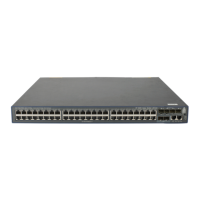310
Configuring IPv6 static routing
Static routes are manually configured and cannot adapt to network topology changes. If a fault or a
topological change occurs in the network, the network administrator must modify the static routes
manually. IPv6 static routing works well in a simple IPv6 network.
Configuring an IPv6 static route
Before you configure an IPv6 static route, complete the following tasks:
• Configure parameters for the related interfaces.
• Configure link layer attributes for the related interfaces.
• Ensure that the neighboring nodes can reach each other.
To configure an IPv6 static route:
Ste
Command
Remarks
1. Enter system view.
system-view N/A
2. Configure an IPv6 static
route.
• Method 1:
ipv6 route-static ipv6-address prefix-length
{ interface-type interface-number
[ next-hop-address ] | next-hop-address |
vpn-instance d-vpn-instance-name
next-hop-address } [ permanent ] [ preference
preference-value ] [ tag tag-value ]
[ description description-text ]
• Method 2:
ipv6 route-static vpn-instance
s-vpn-instance-name ipv6-address
prefix-length { interface-type interface-number
[ next-hop-address ] | next-hop-address
[ public ] | vpn-instance d-vpn-instance-name
next-hop-address } [ permanent ] [ preference
preference-value ] [ tag tag-value ]
[ description description-text ]
Use either method.
By default, no IPv6 static
route is configured.
3. (Optional.) Configure the
default preference for IPv6
static routes.
ipv6 route-static default-preference
default-preference-value
The default setting is 60.
4. (Optional.) Delete all IPv6
static routes, including the
default route.
delete ipv6 [ vpn-instance vpn-instance-name ]
static-routes all
The undo ipv6
route-static command
deletes one IPv6 static
route.

